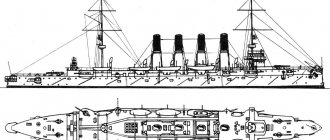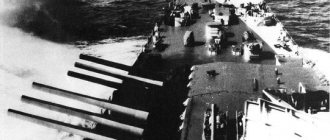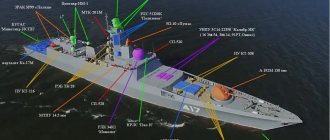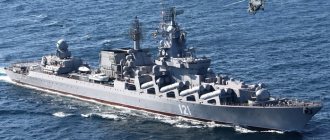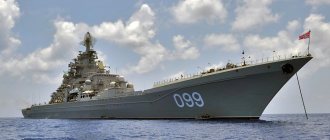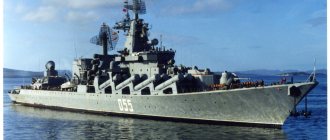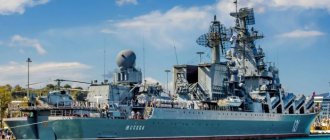For other ships with the same name, see Gromoboy (ship).
| Thunderbolts in 1901 in Australia | |
| Class Overview | |
| Name: | Thunderbolts |
| Operators: | Imperial Russian Navy |
| Preceded by: | Russia |
| Successor: | Bayan class |
| Built: | 1897–1900 |
| On the commission: | 1900–1922 |
| Completed: | 1 |
| Disposed of: | 1 |
| Story | |
| Russian empire | |
| Name: | Gromoboy (Russian: Грумоboy) |
| Builder: | Baltic Shipyard, St. Petersburg |
| Put: | June 14, 1897 [Note 1] |
| Launched: | May 8, 1899 |
| Commissioned: | November 1899 |
| Fate: | Sold for scrap, July 1, 1922 |
| General characteristics | |
| Type: | Armored cruiser |
| Bias: | 12,455 long tons (12,655 t) |
| Length: | 481 ft (146.6 m) |
| Ray: | 68.6 ft (20.9 m) |
| Draft: | 26 ft (7.9 m) |
| Installed power: | 14,500 hp (10,800 kW) |
| Movement: | 3 shafts, 3 vertical triple expansion steam engines, 32 Belleville water tube boilers |
| Speed: | 19 kn (35 km/h; 22 mph) |
| Classify: | 8,100 nmi (15,000 km; 9,320 mi) at 10 kn (19 km/h; 12 mph) |
| Addition: | 874 officers and crew |
| Weapons: |
|
| Armor: |
|
Thunderbolt
(Russian: Gromoboy, meaning "Thunderbolt") is an armored cruiser built for the Imperial Russian Navy in the late 1890s. She was designed as a long-range raider and served as such during the Russo-Japanese War of 1904–05. When the war began, he was based in Vladivostok and during the first months of the conflict he flew several missions in search of Japanese ships without much success.
"Thunderbolt"
with other armored cruisers of the cruising squadron "Vladivostok" in August 1904 tried to meet in the Tsushima Strait with the main part of the Russian Pacific Fleet, departing from Port Arthur.
The fleet was delayed, and the squadron returned to the port alone. . Upon returning, the squadron encountered a Japanese squadron of four armored cruisers, which blocked their path to the base. The Japanese sank the oldest Russian ship, Rurik
, and damaged
Gromoboi
and
Rossia
during the subsequent Battle of Ulsan.
Both Russian ships were repaired within two months. Gromoboi
immediately after repairs ran aground and was out of action for four months. Three months after the damage from the grounding was repaired, she struck a mine but returned successfully to port. Her armament was strengthened during repairs, but she saw no further action during the war.
Thunderbolt
was transferred to the Russian Baltic Fleet after the end of the war and began lengthy repairs, which were completed in 1911. It was largely inactive during the First World War, but its armament and defenses were modernized during the war. In 1918 she was transferred to reserve, and in 1922 she was sold to a German company for scrapping. She ran aground near Liepaja during a storm on her way to Germany and was thrown for scrap.
Design and description[edit]
Originally Gromoboi
was intended to be a repeat of the Rossia, but modifications to the design to include thicker armor and improved engines made this impossible.
The use of ROSSIA
's hull design meant that the ships looked identical. [1]
Thunderbolt
was 481 feet (146.6 m) long overall.
She had a maximum beam of 68.6 feet (20.9 m) and a draft of 26 feet (7.9 m). The vessel's displacement was 12,455 long tons (12,655 t), which is only 95 long tons (97 t) more than designed. It was clad in wood and copper to reduce biofouling. [2] Upon completion, Gromoboi
poorly
balanced
due to the bow, which reduced her speed and caused her to become very wet forward. The weights had to be moved to the stern and ballast added to the stern to adjust the trim, but she subsequently came to be considered a good seagoing boat with a slight, though rapid, list. [3]
Propulsion system[edit]
Thunderbolt
dispense with
ROSSIA
's cruising engine on the central shaft. Three equally powerful vertical triple expansion steam engines were used with a total design power of 14,500 hp. (10813 kW), but in testing they developed 15,496 hp. (11,555 kW) and accelerated the ship to a maximum speed of 20.1 knots (37.2 km/h). ; 23.1 mph). Thirty-two Belleville water-tube boilers provided steam for the engines. She could carry a maximum of 2,400 long tons (2,439 t) of coal. This gave her a range of 8,100 nautical miles (15,000 km; 9,320 mi) at a speed of 10 knots (19 km/h; 12 mph). [2]
Weapons [edit]
Thunderbolt
» main armament consisted of four 8-inch (203 mm) 45-caliber Pattern 1892 guns; The forward pair were mounted in casemates above the bow casemate of the main deck 6-inch (152 mm) gun. The two rear guns were mounted in sponsons on each side of the mizzenmast, covered by gun shields. [4] The guns could be lowered to -5° and raised to 18°. They fired 193.5 lb (87.8 kg) projectiles with a muzzle velocity of 2,950 feet per second (900 m/s), giving a range of 12,000 yards (11,000 m) at an elevation angle of 13°. [5]
Her secondary armament consisted of sixteen 6-inch (152 mm)/45 Model 1892 guns. One gun was mounted under the forecastle, the other at the stern; not a single gun could fire to the side. Most of the remaining guns were mounted in casemates, the forward pair in front of the eight-inch guns on the upper deck, and the rest on the main deck. One pair was mounted on the upper deck, protected by gun shields. [6] The guns could be hinged down to -6° and up to +20°. They fired 91.4 lb (41.5 kg) Model 1907 high-explosive shells with a muzzle velocity of 2,600 feet per second (790 m/s). This gave a range of 12,600 yards (11,500 m) at maximum altitude. At Gromoboy's
there were 240 rounds of ammunition per gun. [7]
Protection against torpedo boats was provided by a variety of light-caliber weapons. At Gromoboi
there were 24 75-millimeter (3.0 in) Canet Pattern 1892 50-caliber guns mounted in sponsons on the upper deck, protected by gun shields. [4] The cannon fired 10.8 lb (4.9 kg) shells to a range of about 8,600 yards (7,864 m) at a maximum altitude of 21° with a muzzle velocity of 2,700 ft/s (820 m/s). The rate of fire ranged from twelve to fifteen rounds per minute. [8]
The ship carried twelve 47 mm Hotchkiss guns. [4] They fired a 3.3 lb (1.5 kg) projectile with a muzzle velocity of 1,476 ft/s (450 m/s) at 20 rounds per minute to a range of 2,022 yd (1,850 m). [9] The ship also carried 18 37-millimeter (1.5 in) Hotchkiss guns. [4] They fired a 1.1 lb (0.50 kg) projectile with a muzzle velocity of 1,450 ft/s (440 m/s) at 20 rounds per minute to a range of 3,038 yd (2,778 m). [10]
Gromoboi
also had four underwater 15-inch (381 mm) torpedo tubes, two on each broadside. [3]
Armor [edit]
The Navy Department hoped to increase the thickness
Gromoboy
armor and increase the armor protection of weapons, but still use the "
Russia
" hull design.
The Ministry also hoped to use the new, stronger Krupp armor, but Russian factories proved unable to produce it when it was ordered, and Harvey armor was used instead. [1] [Note 2] In fact, for Stormbreaker
, the waterline belt was reduced in thickness by 2 inches (51 mm) compared to the older ship to six inches, to better protect her guns. The belt was shortened by 100 feet (30.5 m) to a length of 300 feet (91.4 m). Its height was reduced by 9 inches (229 mm) to 7 ft 9 in (2.4 m); it extended 2 ft 9 in (0.8 m) above the waterline and 5 ft (1.5 m) below the waterline. The belt was covered by six-inch bulkheads fore and aft. [eleven]
Thunderbolt
's casemates were 4.7 inches (119 mm), with two-inch backrests and a 1-inch (25 mm) roof.
A two-inch thick transverse bulkhead fore and aft protected them from thunderstorm fire. The armor deck was thick at 1.5 inches flat and 2.5 inches (64 mm) thick where it sloped down to accommodate the belt. The protective deck extended fore and aft from the armored deck and was 2.5–3 inches (64–76 mm) thick. The change in mechanism allowed Thunderbolt
to dispense with
Rossia
's glacis armor, which was needed to protect the tops of the engine cylinders. The deckhouse had 12-inch (305 mm) thick walls made of Krupp armor. The lift pipes and ammunition lifts were protected by 1.5 inches of armor between the lower and mid decks. [1]
New people, new war
After the war, the Thunderbolts remained one of the main forces of the fleet for a very long time. After the defeat of the Japanese, the situation in the region stabilized, and Russia began to build up its fleets in Europe, and therefore, until 1912, cruisers of this type were also the newest of the large ships of the Pacific Ocean. In 1911-1912, the trinity underwent a major overhaul, and the flag of Rear Admiral N. M. Bukhvostov, a descendant of the “first Russian soldier,” was raised on the Thunderbolt. Under his leadership, “Gromoboy”, “Peresvet” and “Rurik” took part in large-scale events of that time, protecting Russian interests. These ships also took part in the First World War, becoming the main hunters for the squadron of Admiral von Spee in the Pacific Ocean. They failed to save the British ships from defeat at Coronel, but Spee's squadron was overtaken at Picton Island and defeated during a long battle - the winners of the Kaiser's fleet lost to the winners of the Pacific Fleet (Gromoboy, Rurik and Peresvet were regularly among the top five ships based on the results of the shooting), although the victory was by no means bloodless - “Gromoboy” and “Peresvet” were damaged, and only “Rurik” remained relatively unharmed. This was followed by a quick repair in Port Stanley and its completion in Alexandria, after which the ships were registered for a long time in the Mediterranean Sea, where a Russian squadron was formed to help the allies during the Dardanelles operation. The cruisers had a chance to shoot at the enemy there too, including at enemy aircraft - for this, in 1915, 87/30-mm anti-aircraft guns, converted from conventional anti-mine guns, were installed on all ships.
"Rurik" in the Mediterranean Sea, 1915
The Thunderbolts were able to return to the Pacific Ocean only in 1923, and almost immediately they had the opportunity to participate in the “rescue mission” of the deposed Chinese Emperor Pu Yi, who was decided to be made the ruler of pro-Russian Manchuria. This operation was the last serious event in the history of veteran cruisers. Already obsolete ships were required to be excluded from the fleet under the terms of the Washington Treaty - a delay was allowed only until the first new ships were put into operation. Initially, they wanted to turn them into training units, but a detailed examination of the cases and mechanisms revealed an extreme degree of wear and tear on most of the mechanisms. As a result, it was decided to scrap the ships, which was done in 1924. But the names “Thunderbreaker”, “Peresvet” and “Rurik” were well remembered in the Russian Imperial Navy - by decree of Emperor Alexander IV, all new ships of these names immediately received the status of guards, special attention was paid to the recruitment of their crews, as well as their supply and combat training, so that they became “worthy heirs of the military glory of their predecessors.” However, that's another story...
Service [edit]
Thunderbolts
built the Baltic Shipyard in St. Petersburg.
Construction began on June 14, 1897, although it did not formally break ground until May 7, 1898, and the ship was launched on May 8, 1899. On November 24, 1899, the ship was transferred to Kronstadt to complete construction, but was driven aground by sea ice. . She was released three days later, but needed to have her scabbard repaired. She left Liepāja on 10 December 1900 en route
to the Far East and stopped briefly at Kiel, where she was inspected by Prince Henry of Prussia, and at Plymouth, where officers visited the Devonport naval base.
[12] She represented Russia in the adoption of the Australian Constitution, visiting Sydney and Melbourne in April–May 1901 and then visiting Nagasaki in July. [13] Thunderbolt
finally reached Port Arthur on July 29, 1901. She remained in the Pacific until the outbreak of the Russo-Japanese War in 1904. [14] During this journey he was commanded by Karl Petrovich Essen.
Russo-Japanese War[edit]
Thunderbolts
(left) and
Russia
in Vladivostok
By this time Thunderbolt
was assigned to the Vladivostok cruiser squadron under the command of Rear Admiral Karl Essen.
The remaining ships are the armored cruisers Rossiya
and Rurik, as well as the protected cruiser Bogatyr.
At the beginning of the war, the squadron flew several combat missions against Japanese shipping. Only one was reasonably successful: in June 1904, the squadron sank the Hitachi Maru
, which was carrying eighteen 28 cm siege howitzers and over 1,000 troops destined for the siege of Port Arthur. [15]
Battle of Ulsan[edit]
Main article: Battle of Ulsan
During the war, the bulk of the Russian Pacific Fleet was located in Port Arthur, where it was blocked by the Japanese. On 10 August, ships in Port Arthur attempted to break through to Vladivostok, but were repulsed in the Battle of the Yellow Sea. Admiral Jessen was ordered to meet them, but the order was delayed. His ships needed to take off steam, so he did not sortie until the evening of August 13th. "Bogatyr"
was damaged earlier when it landed and did not leave with the squadron. By dawn he reached the island of Tsushima in the Tsushima Strait between Korea and Japan. He turned back to Vladivostok when he did not see any ships from the Port Arthur squadron. 36 miles (58 km) north of the island, he encountered a Japanese squadron under the command of Vice Admiral Kamimura Hikonojo, which was assigned to patrol the Tsushima Strait. Japanese forces had four modern armored cruisers: Iwate, Izumo, Tokiwa and Azuma. The two squadrons passed through the night without noticing each other, and each changed course towards first light. This put Japanese ships on the Russian route to Vladivostok. [16]
Jessen turned northeast when he sighted the Japanese at 05:00, and they followed suit, albeit on a slightly converging course. Both sides opened fire around 05:23 at a range of 8,500 meters (9,300 yd). Japanese ships concentrated fire on Rurik
, to the rear of the Russian formation.
It was shot down quite quickly and began to fall astern of the other two ships. Jessen turned southeast in an attempt to open a firing range, but this blinded the Russian gunners to the rising sun and prevented any of their salvo guns from firing on the Japanese. Around 06:00 Jessen turned 180° to starboard in an attempt to reach the Korean coast and allow Rurik
to join the squadron.
Kamimura followed suit around 06:10, but turned left, which increased the distance between the squadrons. Azuma
then experienced engine problems and the Japanese squadron slowed down to match its best speed.
Firing resumed at 06:24, and Rurik
received three hits to the stern, flooding the steering compartment; she had to control her engines. Her speed continued to decline, exposing her to further Japanese fire, and at about 06:40 her steering jammed to the left. [17]
Thunderbolt
's right side after the battle off Ulsan ; notice the holes in the ship
Jessen made another 180° turn, attempting to insert his two ships between the Japanese and Rurik
, but the latter suddenly turned right, increased speed and passed between Jessen's ships and the Japanese.
Kamimura also turned 180°, so that both squadrons were heading southeast on parallel courses, but Jessen quickly made another 180° turn so that they were heading on opposite courses. Around this time Iwate
, knocking out three 6-inch and one 12-pounder guns, killing 32 and wounding 43.
The Japanese squadron opened range again as it made another 180° turn to port. The Russians changed course for the third time around 07:45 in another attempt to support Rurik,
even though
Russia
itself was burning;
her fires were extinguished in about twenty minutes. Kamimura bypassed Rurik
in the south at 08:00 and allowed two other Russian ships to reach his north and gave them an uncontested route to Vladivostok.
Despite this, Jessen turned back again at 08:15 and ordered Rurik
to return to Vladivostok before turning north at his top speed, about 18 knots (33 km/h; 21 mph). [18]
Around this time, two of Kamimura's elderly cruisers, Naniwa and Takachiho, were approaching from the south. Their arrival allowed Kamimura to pursue Jessen with all his armored cruisers, while the two new arrivals dealt with Rurik
.
For the next hour and a half they fought a fierce battle with the Russians; striking them enough to reduce their speed to 15 knots (28 km/h; 17 mph). Azuma
's engines broke down again during this chase, and she was replaced in
TOKIWA's
. The Japanese closed to a minimum of about 5,000 meters (5,500 yd), but Kamimura then opened up the range to 6,500 meters (7,100 yd). [18]
Close-up of Thunderbolt
» s stern after the battle
Around 10:00, Kamimura's artillery officer mistakenly informed him that Izumo
had expended three-quarters of its ammunition, and he turned back after five minutes of rapid fire.
He did not want to leave the Tsushima Strait unguarded and thought that he could use the remaining ammunition on Rurik
.
By this time, she had been sunk by Naniwa
and
Takachiho,
who
closed
to within 3,000 meters (3,300 yd) of
Rurik
to finish her off.
They radioed Kamimura that she had sunk, but he did not receive the message. Soon after the Japanese turned back, Thunderbolt
and
Rossia
were forced to heave-to to make repairs. [19]
Thunderbolt
suffered 87 killed and 170 wounded;
far more than Russia
's 44 killed and 156 wounded.
This was due to ROSSIA
's technical policy of the Captain's orders of gun crews for his fast-firing guns on the engaged side to lie down and those on the unoccupied side to go lower, unlike
Thunderbolt
keeping her light guns manned at all times.
[20] Gromoboi
received fifteen hits on the starboard side of the hull and seven times on the port side, as well as other hits on pipes, boats and decks. She also suffered fire damage due to excess gunpowder charges igniting. Despite so many hits, she was not seriously injured because her waterline belt was not penetrated. It was repaired within two months using basic equipment from Vladivostok. [21]
Immediately after repairs, she ran aground near Vladivostok on October 13 and was not ready for sea until February 1905. [22] The Russians took this opportunity to reinforce her armament with a further six six-inch guns mounted on her upper deck, covered by light rigging. armored casemates. Her armament was also rearranged, with the forward six-inch guns moved from the casemates to the forecastle and the rear six-inch guns moved forward. Space for these changes was made by removing many of her light guns; she retained only nineteen 75 mm and two 37 mm guns. She also received several Barr and Stroud rangefinders during this time. [3] While testing her new Telefunken radio equipment on 24 May, she struck a mine near her forward boiler room. She was able to return to Vladivostok for repairs, but did not participate in the war again. [22]
Interwar period[edit]
Thunderbolt
returned to the Baltic Fleet after the war.
There she underwent lengthy repairs, which were completed in 1911. Her engines and boilers were repaired and her rear torpedo tubes were removed. The forward 15-inch torpedo tubes were replaced with 18-inch (460 mm) ones. Her foremast was removed and replaced by a mizzenmast; her mainmast was moved aft in place of the mizzenmast and searchlights were mounted on a platform on each mast. A casemate with 3-inch sides and a 1-inch roof was built around the rear eight-inch guns, and the rear six-inch guns were moved aft and protected by a casemate with two-inch sides and 0.75-inch (19 mm). mm) roof. The thickness of the upper deck casemates was increased to two inches. For her rangefinders, armored turrets were built at the bow and stern. Her light armament was reduced to four 75 mm and four 47 mm guns. The engines were tested in late 1910 and were unsatisfactory as they overheated and produced only 9,979 horsepower (7,441 kW). Tests were carried out again on 27 July 1911 and were more satisfactory as they developed 13,337 horsepower (9,945 kW) while the Gromoboi
reached 18.5 knots (34.3 km/h; 21.3 mph) . [3]
First World War[edit]
Thunderbolts
ran aground near Liepaja
Thunderbolt
served in the 2nd Cruiser Brigade of the Baltic Fleet during the First World War. It was modified to serve as a fast minelayer for two hundred mines. [3]
She engaged the German battlecruiser SMS Von der Tann at the entrance to the Gulf of Finland on 10 August 1915.
In 1916–1917 Its weapons were also changed [23] ; she replaced the six-inch guns fore and aft with eight-inch ones. These additions increased her broadside to four eight-inch and eleven six-inch guns. All of her remaining light guns were removed and she received two 2.5-inch and two 47 mm anti-aircraft guns. All these additions increased her displacement to approximately 13,200 long tons (13,412 t). [3]
Thunderbolts
came under the control of the Soviet Red Fleet in September 1917.
The Treaty of Brest-Litovsk required the Soviet Union to evacuate their base in Helsinki in March 1918 or be interned by newly independent Finland, although the Gulf of Finland was still frozen. Thunderbolt
went to Kronstadt on the so-called “Ice Journey” and was transferred to reserve shortly after arrival. [24]
“Avelan’s little cruising war,” or how the admiral defended new cruisers
F. K. Avelan - Comrade Minister of the Navy in 1897-1905, Minister of the Navy in 1905-1913
Having become a comrade of the Minister of Maritime Chikhachev in 1897, Fyodor Karlovich Avelan developed vigorous activity. It concerned primarily Russian cruisers. Before this, their construction was carried out sluggishly, as needed and without a special system, preference was definitely given to large armored cruisers. There were also active defenders of the idea of armored cruisers for raider operations, the construction of which was interrupted after Admiral Nakhimov, albeit for economic reasons [1] . Avelan, with the support of Chikhachev, began to bring all this into a single system. Cruisers began to be built much more actively, while he actively defended (and did defend by 1899) the division of armored cruisers of rank II into II and III, i.e. large combat and small reconnaissance cruisers with an armored deck. At the same time, the former III rank was transferred to IV (all unarmored and auxiliary cruisers), and I remained unchanged (belt armored cruisers). The very theory of cruising warfare now changed its essence - the active use of all available cruisers on enemy communications was no longer envisaged. Avelan justified this by the fact that specially built cruisers are too expensive ships to actually exclude them from combat squadrons, and therefore for raiding in the ocean it is better to use outdated ships (meaning the North Sea squadron [2] ) and auxiliary ones. cruisers converted from civilian fast transports. The new armored cruisers were henceforth intended to serve in the squadron as patrol, reconnaissance and auxiliary warships. This “normalization” led to the fact that instead of 10 armored cruisers in 1898, by the beginning of the REV, the fleets of the Russian Empire already included 21 ships of cruisers of ranks II and III.
N. M. Chikhachev, Minister of the Navy of the Russian Empire in 1888-1905. Even after his retirement after the Russo-Japanese War, he retained sufficient influence on the fleet to be considered the “father of the Russian fleet” until his death in 1917.
After this, Avelan took up rank I cruisers. At the same time, he actually became a successor to the work of Chikhachev, who was initially an opponent of armored cruiser-raiders (the construction of which ceased with the beginning of his ministry). But if the minister did not see any point in building such ships, preferring to protect full-fledged battleships with belt armor, then Avelan had his own thoughts on this matter. Since 1898, he began to actively promote the idea of armored battle cruisers, which, due to their superior speed over conventional battleships, could occupy advantageous positions for firing at enemy end ships. Together with the “Ushakov” tactics that were popular at that time - trying to disable the enemy flagship first - these ships were supposed to become a “trump card”, a high-speed wing of the battle fleet, which, in addition to acting against the end ships of the enemy formation, could also serve as reconnaissance in force due to its high survivability and speed. At the same time, they had to have both serious weapons and armor protection, and high speed - which led to the main problem of the concept itself: the cost of such a ship was very close to the cost of battleships.
It was precisely because of the high cost that Avelan’s idea did not receive the support of even the Minister of the Navy Chikhachev, who still did not believe that something sensible could be obtained from a rank I cruiser. Attempts to interest royal persons in this project were also unsuccessful - Emperor Alexander III [3] , and Tsarevich Nicholas, and even Grand Duke Alexander Alexandrovich [4] , an ardent flotation enthusiast, showed no interest in such a ship. In the end, Avelan had to seek support from the lower ranks in order to arouse initiative from below, which was only welcomed under Chikhachev. He received support from Admiral Makarov, who at that time had recently taken command of the Baltic Fleet. During the summer exercises of 1899, which took place in the presence of the Minister of the Navy, the armored cruisers Admiral Kornilov, Admiral Istomin and Svetlana were allocated as the high-speed wing of the fleet. During the “battle” between two columns of battleships, this “winged detachment” twice engulfed the head of the “enemy” column - however, after that it was conditionally destroyed by enemy armored cruisers. Avelan focused attention on the fact that if the “winged detachment” included well-protected, high-speed and powerfully armed armored cruisers, the enemy flagship would very quickly fail (at least), and armored cruisers would not even risk contacting enemy ships armed with heavy cannons. At the same time, there was no need to build a large number of such ships - after all, they, in fact, played the role of heavy cavalry attacking the enemy in the flank, while the infantry (battleships) fought the main enemy forces. These arguments, as well as the clear results of the maneuvers, forced Chikhachev to agree with the need to build “a small series of rank I armored cruisers.” The project was given the go-ahead, and the process of creating a new type of armored cruisers began.
Footnotes [edit]
- ^ abc McLaughlin, page 55
- ^ ab McLaughlin, pp. 55, 74
- ^ B s d e e McLaughlin, p. 60
- ^ abcd Watt, page 93
- "Russian 8" / 45 (20.3 cm) Sample 1892 203 mm / 45 (8 ") Sample 1892". navweaps.com. September 11, 2006. Retrieved April 30, 2010.
- Brook, page 38
- "Russians 6" / 45 (15.2 cm) Sample 1892 152 mm / 45 (6 ") Sample 1892". navweaps.com. January 12, 2009. Retrieved May 1, 2010.
- "Russian 75 mm / 50 (2.95") Model 1892 - French 7.5 cm / 50 (2.95") Model Canet 1891" . Navweps.com. July 17, 2007. Retrieved February 11, 2022.
- "Russia 47 mm/5 (1.85 in) Hotchkiss gun 47 mm/1 (1.85 in) Hotchkiss gun [3-pounder (1.4 kg) Hotchkiss guns]". December 1, 2006. Retrieved December 22, 2009.
- "Russia 37 mm/5 (1.5 in) Hotchkiss Pistol 37 mm/1 (1.5 in) Hotchkiss Pistol [1 lb (0.45 kg) Hotchkiss Pistol]". December 1, 2006 Archived from the original on May 4, 2012. Retrieved December 22, 2009.
- Gardiner, page 190
- "Naval and Military Intelligence". The Times
(36336). London. December 27, 1900 p. 4. - "Naval and Military Intelligence". The Times
(36517). London. July 26, 1901 p. 8. - McLaughlin, page 77
- Brook, page 34
- Jump up
↑ Brook, pp. 34, 37 - Jump up
↑ Brook, pp. 39, 43 - ^ab Brook, p. 43
- Jump up
↑ Brook, pp. 43, 45 - Brook, page 45
- Jump up
↑ Brook, pp. 45–47 - ^ ab McLaughlin, pp. 77–78
- Gardiner and Gray, p. 295
- ^ a b McLaughlin, page 78
- "Imperial and foreign news". The Times
(42551). London. October 26, 1920 col F, p. 9. - ↑
Associated Press, "Russ Cruisers Lost In Storm",
The San Bernardino Daily Sun
, San Bernardino, California, Monday, October 23, 1922, Volume L, Number 237, Page 3.
Links[edit]
- Brook, Peter (2000). "Armored Cruiser vs. Armored Cruiser: Ulsan, August 14, 1904." In Preston, Anthony (ed.). Warship 2000–2001
. London: Conway Maritime Press. ISBN 0-85177-791-0. - Frampton, Victor; Head, Michael; McLaughlin, Stephen and Spurgeon, H. L. (2003). "Russian warships near Tokyo Bay." Warship International
.
XL
(2):119–125. ISSN 0043-0374. - Gardiner, Robert, ed. (1979). Conway's World Warships 1860–1905. Greenwich: Conway Maritime Press. ISBN 0-8317-0302-4.
- Gardiner, Robert and Gray, Randal, eds. (1985). Conway's Fighting Ships of the World: 1906–1921
. Annapolis: Naval Institute Press. ISBN 0-85177-245-5. - McLaughlin, Stephen (1999). "From Ruirik to Ruirik: armored cruisers of Russia." In Preston, Anthony (ed.). Warship 1999–2000
. London: Conway Maritime Press. ISBN 0-85177-724-4. - Watts, Anthony J. (1990). Imperial Russian Navy
. London: arms and armor. ISBN 0-85368-912-1.
Under the flag of Rear Admiral Baranov
"Rurik" during the transition to the Far East, mid-1903
Three Thunderbolts were assigned to a special 2nd combat detachment of the 1st Pacific squadron, based in Port Arthur. Rear Admiral G.K. Baranov took command in the Baltic. Since all three ships were “newcomers”, and the premonition of war was in the air, the 1st Squadron abandoned the planned “winter voyage” to foreign ports and began to conduct intensive combat training. Admiral Baranov “drove” his ships mercilessly - in the shortest possible time it was necessary to improve combat training from “none” to “satisfactory”, or better yet, “excellent” level. Fortunately, the Thunderbolts managed to avoid problems with machinery - they were assigned experienced mechanical engineers from the Black Sea and Baltic ships who knew how to handle Norman-MacPherson water-tube boilers. Just a few years earlier, all three battleships of the “Prince Potemkin-Tavrichesky” type experienced problems with new boilers, and the first three battleships with such a “heart” - “Sisoy the Great”, “Ingermanland” and “Svyatoslav” - due to the novelty of their machinery and lack of experience, the teams were so “gone” that five years after entry into service, without major repairs, they could not develop more than 13-14 knots [11] instead of the passport 17.
"Thunderbolt" in olive war paint, mid-1904
In the event of war, the Thunderbolts were planned to be used as a simple continuation of the battle line of the 1st squadron, but already in the first battle, the three ships of Rear Admiral Baranov showed themselves most clearly, managing to shoot at Japanese battleships and seriously damage the enemy armored cruiser. As a result, these three cruisers became the most active large ships of the Russian fleet of that war, and more than once set off on independent voyages, be it a raid on enemy patrols, supply lines at Chemulpo, or reconnaissance in a particularly dangerous area. Their impressive speed allowed them to catch up with most Japanese cruisers, including armored cruisers, and deal with them without much effort. Of course, all this did not go unpunished - the ships were often damaged by Japanese fire, and during the entire war only one flagship Thunderbreaker was not blown up by mines. Fortunately, all these damages were not fatal, and the trio of Russian cruisers of the 1st rank had the opportunity to play their important role in the decisive battles at sea as a “high-speed wing”. After the war, Gromoboy, Peresvet and Rurik, together with their crews, commanders and Rear Admiral Baranov, became heroes, and even surpassed in popularity the flagship battleship of Admirals Makarov and Vorontsov, Prince Potemkin-Tavrichesky.
